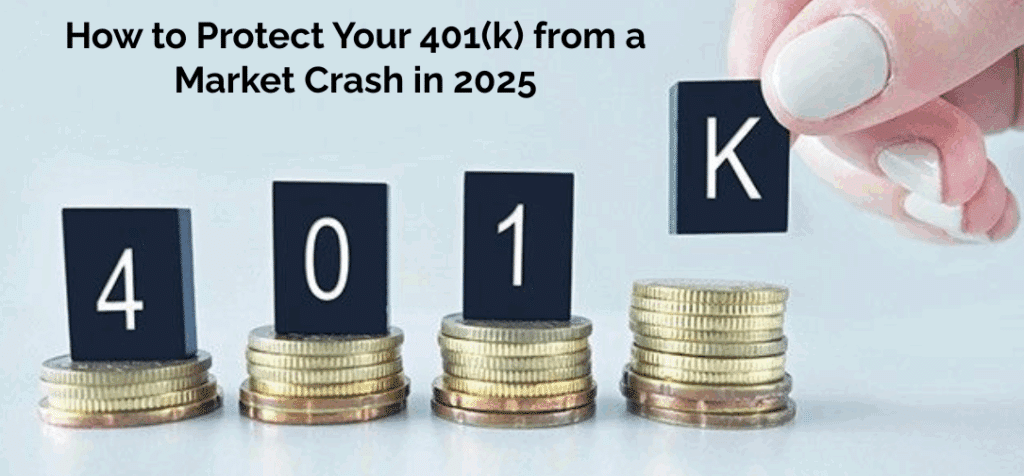How to Protect Your 401(k) from a Market Crash in 2025
Why 401(k) Protection Matters
Your 401(k) is the backbone of your retirement plan, but what happens when the stock market takes a turn for the worse? Economic downturns and market crashes can significantly impact retirement accounts, especially if you’re nearing retirement age. That’s why protecting your 401(k) is not just smart—it’s essential.

Understanding How Market Crashes Affect Your 401(k)
A market crash typically leads to a sharp decline in stock values. Since most 401(k)s are heavily invested in equities, they’re vulnerable during downturns. Depending on your portfolio’s allocation, you could lose a substantial portion of your retirement savings if you’re not proactive.
How to Protect Your Retirement Savings from Inflation
Inflation silently eats into your savings over time. Here are some inflation-proof strategies:
- Invest in inflation-hedged assets like TIPS (Treasury Inflation-Protected Securities), gold, and real estate.
- Avoid holding too much cash, which loses value as prices rise.
- Increase contributions to outpace inflation’s impact on your long-term goals.
- Reevaluate your income needs annually and adjust your investment plan accordingly.
Learning how to protect your retirement savings from inflation is essential to maintain your standard of living in retirement.
Top Signs a Market Crash May Be Coming
Recognizing early warning signs allows you to act before it’s too late. Common indicators include:
- Rising inflation and interest rates
- Inverted yield curves
- Declining corporate earnings
- Increased volatility in financial markets
- Global economic instability or geopolitical tensions
Staying informed and monitoring economic trends can help you make timely adjustments to your 401(k).
7 Proven Strategies to Protect Your 401(k) from a Crash
A. Diversify Your Portfolio
Don’t put all your eggs in one basket. Diversify across asset classes—stocks, bonds, real estate, and precious metals. This reduces risk and balances your returns.
B. Shift to Low-Risk or Stable Value Funds
Stable value funds offer modest returns but carry minimal risk. They’re ideal for conservative investors looking to protect capital during market uncertainty.
C. Increase Bond Allocation
Bonds typically perform better when stocks fall. Adding high-quality government or corporate bonds to your 401(k) can offer stability during a downturn.
D. Rebalance Regularly
Rebalancing your portfolio ensures it stays aligned with your risk tolerance and investment goals. Market changes may alter your allocation, requiring adjustments.
E. Use Stop-Loss Orders (If Applicable)
While not all 401(k) plans support this, if you manage a self-directed account, stop-loss orders can help limit your downside during a sudden crash.
F. Avoid Panic Selling
Selling during a market crash locks in your losses. Historical data shows that markets tend to recover over time. Stay invested or adjust your strategy with a rational mindset instead of reacting emotionally.
G. Consider Rolling Over to a Gold IRA
Precious metals like gold are known to retain value during market crashes. Rolling over a portion of your 401(k) to a Gold IRA Investment adds a layer of protection and diversification.
The Role of a Financial Advisor in Times of Volatility
An experienced financial advisor can provide custom guidance based on your age, goals, and risk tolerance. They can also help rebalance your 401(k), analyze investment options, and prepare you for downturns.
Gold & Precious Metals: A Hedge Against Market Risk
Gold and silver have historically performed well during times of economic uncertainty. Including physical precious metals in your retirement plan through a Gold IRA can:
- Preserve purchasing power
- Hedge against inflation
- Reduce overall portfolio volatility
Platforms like Gibraltar Group offer trusted Gold IRA services that allow you to roll over part of your 401(k) into physical gold without penalties.
What Not to Do During a Market Crash
Here’s what you should avoid:
- Don’t cash out early – You’ll face penalties and miss potential rebounds
- Don’t stop contributing – Continue contributions to buy at lower prices
- Don’t chase high-risk “safe haven” assets without research
- Don’t ignore your portfolio – Stay involved, stay informed
Case Study: How Investors Protected Their 401(k) in Past Crashes
During the 2008 financial crisis, those who shifted to bonds and stable funds saw lower losses. Others who diversified into gold or real estate saw quicker recoveries. A key takeaway: proactive planning outperforms emotional reactions.
Learn more about how to convert 401(k) to a gold ira
Frequently Asked Questions (FAQ)
Q1: Can I move my 401(k) to a Gold IRA without penalty?
Yes, if done correctly as a rollover through a trusted provider like Gibraltar Group.
Q2: How often should I rebalance my 401(k)?
Generally, every 6–12 months or after major market movements.
Q3: What’s the safest investment in a 401(k)?
Stable value funds, treasury bonds, and money market funds are among the safest.
Q4: Should I stop contributing during a crash?
No. Crashes are often the best time to invest more due to lower asset prices.
Final Thoughts: Stay Calm, Stay Strategic
Market crashes are inevitable, but losses don’t have to be. By diversifying your 401(k), seeking professional advice, and considering safe havens like gold, you can weather the storm and come out stronger. Your future deserves a solid plan—don’t wait for a crash to start protecting it.

